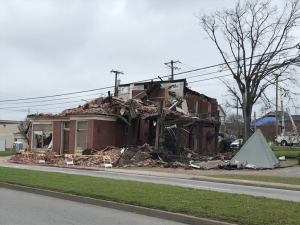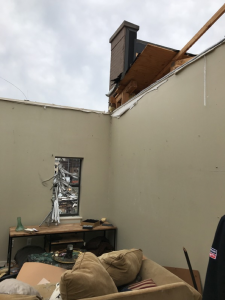The Destroyed Houses from the Nashville, TN, Tornado
David O. Prevatt, Ph.D., an associate professor in the Engineering School of Sustainable Infrastructure and Environment (ESSIE) within the Herbert Wertheim College of Engineering, conducts structural engineering research to advance the sustainability of communities subjected to severe wind events. On March 3, 2020, a tornado touched down in Nashville, Tenn., resulting in over 20 fatalities and the destruction of dozens of buildings. Dr. Prevatt deployed to Nashville to conduct a post-tornado damage investigation.

Dr. Prevatt serves as a co-director of the NSF- supported Structural Extreme Events Reconnaissance (StEER) Network. This organization fields forensic engineering teams that collect post-event field data needed to understand the failure patterns in buildings. These efforts are critical for the cost-effective improvement of building codes for tornado-resilient communities.
“The U.S. does not yet have a tornado-resilient building code and so structures aren’t designed for such extreme loads,” Dr. Prevatt said. “Unfortunately, the existing guidelines for structural design of houses, in particular, include several known weaknesses in their components and connections that make them far too vulnerable to extreme winds.”
As a wind and structural engineer, Dr. Prevatt has led or participated in more than a dozen post-tornado damage surveys since 2011, and he repeatedly observes similar preventable causes of building failures.

The Nashville tornado was no different, as the researchers found weak or missing connections in the buildings’ load path that made them vulnerable to catastrophic failures.
The detailed, comprehensive 100-page Early Access Virtual Reconnaissance Report (EARR) released on April 13, presents evidence collected using street view cameras, UAV cameras and detailed door-to-door assessments. The EARR report includes recommendations from five previous tornado damage assessment reports and recommends methods to mitigate structural damage. It is hoped the Nashville officials will use this report as they develop options for revising their building codes.

“It is sad to see many families suffer complete loss of their houses due to insufficiencies that have been known for decades,” Dr. Prevatt said. “Since the 1970 Lubbock tornado, which happened 50 years ago this month, engineers have said that building structures should be tied to foundations. But in Nashville, many of the houses that failed did not have these ties and, as a result, suffered catastrophic damage.”
Dr. Prevatt hopes that planners for wind hazard-prone communities will take this report and a wealth of existing supporting literature into consideration. It is obvious that future housing can be built to be more resilient with the right connections in the right places, but it is also true that the existing building stock can be dramatically improved through proper retrofits to mitigate weaknesses.
“The only way to change the paradigm is to shift towards structural systems that include robust vertical and lateral load paths. We can upgrade today’s houses and build tomorrow’s houses for a more resilient future,” Dr. Prevatt said.
